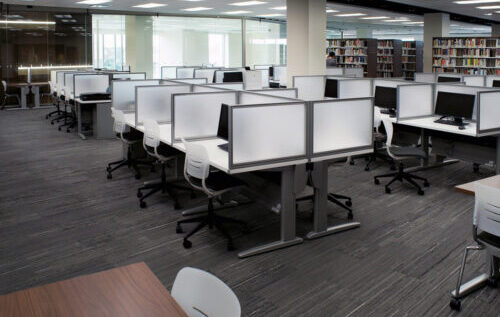
Five School Library Design Tips

With the reopening of school libraries, comes the need to reinforce health and safety concerns for all students. Educators are also tasked with providing a welcoming facility. In 2020 the American Library Association held their annual conference virtually. A key takeaway from participants was to create ways to grant safe social interaction.
At bluespace interiors, we are offering our best design strategies for safe, productive and inviting libraries during this changing pandemic environment.
1. Plan for Variety and Safety
Some students prefer quiet areas free from distractions, others need shared spaces to collaborate with fellow students. Libraries host many activities while accommodating various needs like group meetings, socializing and even study breaks. Dividers and screens can help to define spaces. Height-adjustable screens are available to clamp onto desks. Mobile screens with markerboard surfaces are another option.
2. Enhance Agency
Layouts with clear divisions and strict social distancing are needed for the immediate return to school. bluespace interiors recommends using flexible design solutions in order to allow for future scenarios where a greater number of students will need to use library facilities. Flexible library designs can encourage project-based learning. Using lessons from class, students work to solve real-world problems. Project-based learning gives students control over their environment. Virtually everything libraries might need, including chairs, stools, desks, booths, lecterns and storage are available on casters, so students or staff can reconfigure the physical environment.
3. Integrate Technology
Libraries routinely hosted distance-learning, computer simulations of real-world events and educational video games, pre-pandemic. Remote learning will continue for some time even after schools reopen. An example might be where students use their libraries to interact with instructors teaching from home or guest lecturers many miles away. This will require that libraries are able to support technology for virtual learning.
4. Be Inviting
If a library provides a clean welcoming space, students will want to spend time there. Surfaces that are easy to clean include desks and seating in plastic, laminate and acrylic finishes. Screens and movable walls come in acrylic finishes and glass surfaces as well.
5. Include Daylighting
Natural light enhances a study environment. Students who study with natural light have better work habits, fewer sick days and perform better on assessments. As campuses reopen, glass architectural walls can create an open, well-lit study space and separate smaller areas in a room to support social distancing.
Flexible design strategies applied to libraries can play important roles for students’ education and social interaction while they guard students’ health and safety. bluespace interiors is here to help.









